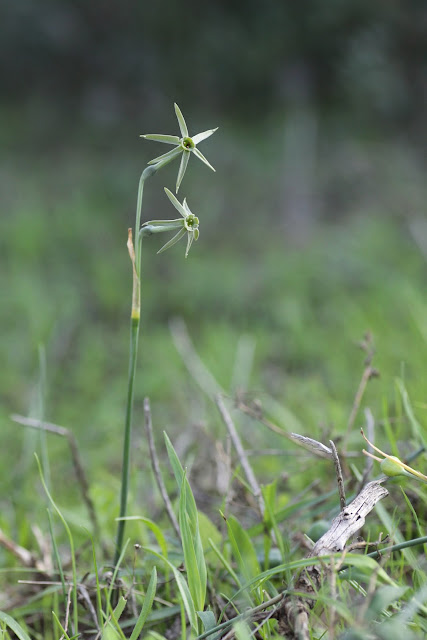Daffodils are spring flowers, we all know that. But this is natural history, and there are exceptions to almost every rule, just to make life difficult or interesting, depending on how neat and ordered you wish the world were. There are four or five autumn-flowering Narcissus in Europe, including what I think of as the strangest of them all: the green-flowered Narcissus viridiflorus, the object of today's excursion to the south-west of Los Alcornocales National Park.
This daffodil has a refuge along the road to Cañada de la Jara. The narrow verges between the fence and the road are free from grazing animals, which seem to have done their best to eat off any flowers that might be foolish enough to try blooming inside the enclosure. Not the most alluring of localities for a rare plant, but at least it seems to be here in good numbers.
The plant itself is alluring. The fist pictures I saw of it, in John Blanchard's book, made it look rather ungainly. It did not have the brightness of the yellow or white daffodils, and the photo was not as pleasing as those of the other Narcissus. It stood out because of its almost ugly appearance, and the poorer photograph strangely added to its appeal. I have noticed this before: the perfectly composed beautiful poster shot is stunning and makes you feel glad to be sharing a world with whatever it depicts. But the image of a plant or a bird that looks as though it was taken under trying circumstances has a different effect that can be just as engaging. The message here is different. Rather than portraying beauty, this picture tells of a precious moment, so rare an event that there is only one chance to grab whatever image you can. No chance to try again or to find the prefect angle on a well lit plant against a pleasing background. These are rare encounters and you take whatever you can from them. The words describing the European distribution of Narcissus viridiflorus confirmed the impression given by the photograph: 'limited to a small area around Algeciras'. Here was a rarity and a challenge. As previous autumns had turned to winter I had thought about going south and plant hunting again, but I was always too late. This year my wanderlust had arrived just in time, so I set about turning the fantasy of an encounter with this strange plant into reality.
In life it was almost as I expected it to be, but the glaucous bloom, an illusion from many tiny white dots on the flowers, was a pleasant surprise. The flowers were as narrow and star-like as the pictures promised, and it was indeed difficult to spot amongst the general greens of the countryside. Because this is such an uncontroversial daffodil I cannot make my usual comments on how hard it is to identify and how its names have been fought over by various botanists: it is an uncomplicated plant that we can simply enjoy.
The daffodil shared its road verges with Late Crocus Crocus serotinus, a much more widespread plant, found through most Iberia. The familiar bird's-nest fungus Cyathus olla was here too, growing on small twigs. Its nests were at various stages, from fully covered kettle drums to wide open baskets revealing their clutch of mini eggs at the bottom.





